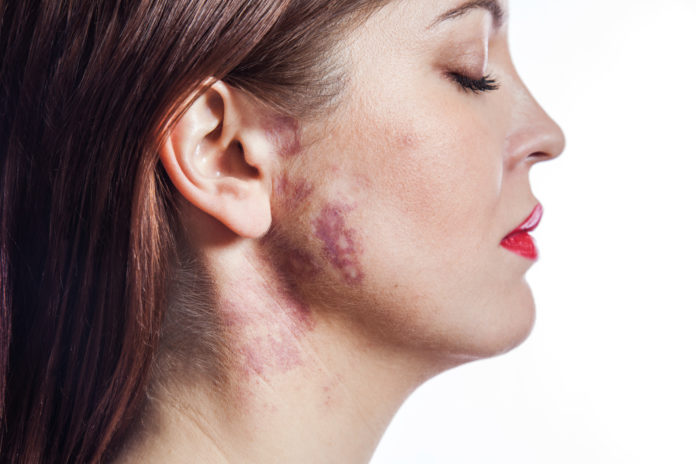Overview
Birthmarks are discolourations on your skin that might occur at birth or early childhood. Birthmarks can be in many different colors, like black, brown, tan, pink, pale blue, red white or purple. A few birthmarks are only colorations of the skin’s surface, while others are raised above the skin’s surface or extend into the tissues under the skin. They are of two types, red and pigmented. The reason for red birthmarks is the underlying blood vessels. In pigmented birthmarks, there is a notable change in the skin’s color.
About pigmented birthmarks
A pigmented birthmark can be of various colors as per the type, like brown, blue, black, and can be of lighter or darker shades. This is due to the difference in melanin production.
Types of pigmented birthmarks
- Pigmented nevi or Moles: These are usually black, brown, or chocolate-colored. They are generally on the surface of the skin, neither depressed nor elevated. These typically appear as a single birthmark. At times, they can appear in groups. Moles come up when cells in your skin grow in a cluster instead of spreading throughout your skin. Moles may get darker after exposure to the sun, during the teen years, while taking some birth control pills, and during pregnancy.
- Mongolian spots: In individuals with darker skin tones, these mongolian spots are commonly seen. These are spots on the skin’s surface. They might be bluish or blue-black. Mostly located on the buttocks or the lower waist region, sometimes they might be on the trunk or arms.
- Cafe-au-lait spots: These are oval-tanned or brown spots present on any part of the body. These spots can be present at birth or can appear in early childhood. If one such spot is present, it is not associated with any syndrome. If they are present in multiple regions and are larger in size , they might indicate neurofibromatosis, a rare genetic condition.
- Congenital nevi: One in every hundred individuals are born with one or many congenital moles. These are pigmented spots present from birth. However, these are more likely to turn cancerous. If a congenital nevus is more than 20 cm in size, it can become cancerous. If you or your baby has such a nevus, visit your physician to get it examined at the earliest.
Symptoms of pigmented birthmarks
There are no symptoms of pigmented birthmarks. Usually, they are painless. They might change color and size with age. They might get bigger with exposure to the sun and changes in the body’s hormone levels, such as those occurring during pregnancy. Sometimes, it might cause itching and bleeding.
What causes pigmented birthmarks
There is no known cause for the occurrence of birthmarks. In benign moles, they might change color with increasing age and during the teenage years, pregnancy, or exposure to the sun. It occurs due to the melanin deposition caused by overactive melanocytes. It can sometimes occur due to underlying conditions like neurofibromatosis.
How are pigmented birthmarks diagnosed?
Pigmented birthmarks are diagnosed during physical examination. Your doctor will take a close look at the mole or pigmented birthmark you or your child might have. Your doctor might recommend a biopsy if needed to make the diagnosis.
Treatment of pigmented birthmarks
Pigmented birthmarks need no treatment. One needs to keep an eye on the birthmark and contact the doctor if there are any changes.
If you feel aesthetically challenged due to the pigmented birthmark, you can consider covering them with makeup. If the mark is huge and spread wide on the skin’s surface, you can consider cosmetic surgery. Surgery is generally recommended if the pigmented birthmark is on the face or arms or suspected of cancerous change.
.
Call 1860-500-1066 to book an appointment.
How to prevent the occurrence of a pigmented birthmark?
There is no way to prevent a pigmented birthmark from appearing. The cause is unknown, and hence its prevention too. It is usually seen that birthmarks run in the family. You might notice that if you have pigmented birthmarks, your parents also likely have them. In order to prevent complications, people with birthmarks should actually use a good quality sunscreen with an SPF of 30 or higher when they are outdoors.
Conclusion
Birthmarks are benign spots that might occur at birth or later in early childhood. One need not worry about them unless there is a significant change in the birthmark.
Frequently Asked Questions (FAQ)
Are birthmarks genetic?
While a few birthmarks are hereditary and run in families, most are not. Very rarely, some birthmarks are caused by gene mutations. For instance, some babies born with port-wine stains have a rare condition called Klippel-Trenaunay syndrome. This syndrome is caused by a genetic mutation that is not generally inherited. Another rare condition, Sturge-Weber syndrome, also appears as port-wine birthmarks and is caused by a different gene mutation. It also doesn’t run in families and can’t be inherited.


















